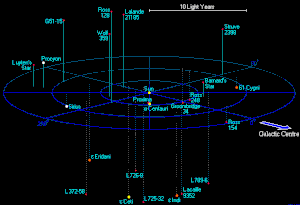| Light-year | |
|---|---|
 | |
| General information | |
| Unit system | astronomy units |
| Unit of | length |
| Symbol | ly[2] |
| Conversions | |
| 1 ly[2] in ... | ... is equal to ... |
| metric (SI) units | |
| imperial and US units |
|
| astronomical units | |
A light-year, alternatively spelled light year (ly or lyr[3]), is a unit of length used to express astronomical distances and is equal to exactly 9460730472580.8 km, which is approximately 5.88 trillion mi. As defined by the International Astronomical Union (IAU), a light-year is the distance that light travels in vacuum in one Julian year (365.25 days).[2] Despite its inclusion of the word "year", the term should not be misinterpreted as a unit of time.[4]
The light-year is most often used when expressing distances to stars and other distances on a galactic scale, especially in non-specialist contexts and popular science publications.[4] The unit most commonly used in professional astronomy is the parsec (symbol: pc, about 3.26 light-years).[2]
- ^ "The Universe within 12.5 Light Years – The Nearest stars". www.atlasoftheuniverse.com. Retrieved 2 April 2022.
- ^ a b c International Astronomical Union, Measuring the Universe: The IAU and Astronomical Units, retrieved 10 November 2013
- ^ Mutel, R. L.; Aller, H. D.; Phillips, R. B. (1981). "Milliarcsecond structure of BL Lac during outburst". Nature. 294 (5838): 236–238. Bibcode:1981Natur.294..236M. doi:10.1038/294236a0.
- ^ a b Bruce McClure (31 July 2018). "How far is a light-year?". EarthSky. Retrieved 15 October 2019.